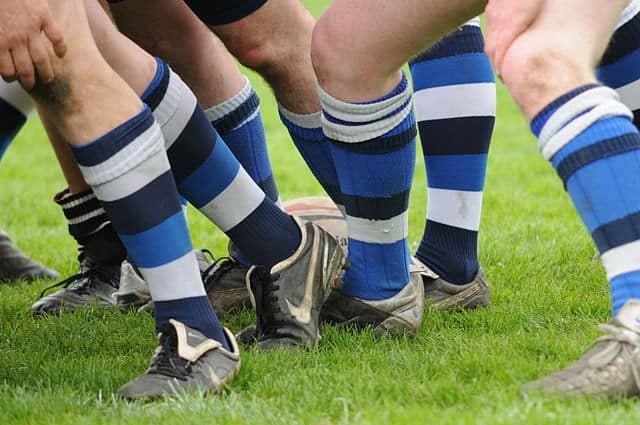During my thirty year playing career I have worn shin pads on and off for different reasons, often related to the position I was playing, weather conditions or my mindset at the time.
Shin guards are allowed in rugby and are occasionally worn by players, usually forwards who feel that their shins are particularly at risk in tackles, scrums, rucks and mauls. They may also be worn by players trying to protect an injury to the shin or calf area.
Let’s take a closer look at why certain shin pads and guards are, or aren’t legal in rugby and what you need to know if you do want to wear shin pads/guards.
World Rugby’s Official Rugby Shin Guard Rules
World Rugby who are responsible for the laws governing the game clearly state in regulation 12 that:
“A player may wear shin guards worn under the socks with padding incorporated in non-rigid fabric with no part of the padding thicker than 5mm when compressed.“
– World Rugby
That sounds simple but let’s break that down a bit further. Firstly, the word ‘non-rigid’ is key. Non-rigid obviously excludes the use of plastics to provide solid protection at the front of the shin or even used as a framework or structure for the padding. It can’t even be used as a plate covering the front of a foam pad.
The reason for this is clear, imagine throwing yourself at the legs of an opponent and getting caught by a sharp abrasive edge of a plastic shin guard protruding out the top of a sock. This could cause nasty facial lacerations and is the reason why soccer blades and rubber studs are banned too. You can read more about rules for rugby boots here.
Typically, the refer will line players up prior to the game during the warm up and check players studs and protective gear. They can refuse to let a player play with any protective gear that they deem is dangerous and/or breaking the rules.
In fact, if they notice a player has put a piece of protective gear back on that they were ordered not to wear then they can order them from the field of play, i.e. sent off! It is a serious issue, imagine taking your child to play a game of rugby on a Sunday morning only to bring them home with lacerations across their face.
The second important detail to note from the ruling is the 5mm ruling. Half a centimeter does not provide much protection to be honest, regardless of the type of material, which remember has to be non rigid fabric and it prevents players from wearing any bulky padding that might be seen in other contact sports.
You have to be careful but you can find rugby ready shin pads on Amazon, you just need to be a bit picky.

Rugby Shin Pads Vs Football Shin Pads
The difference between rugby and football shin guards is as follows:
Rugby shin pads are generally less bulky being less than 5mm thick and containing no rigid elements whereas football shin pads frequently have a rigid plastic base covering a layer of foam which forms more of a shield structure typically around 1 cm in thickness.
The rigidity of the football shin pads and greater thickness is what means that your average football shin pads should not be worn in rugby matches. That said, my favourite set of shin pads were of the football variety with removable plastic shield elements and I got away with those for years. Had I relayed how dangerous they potentially were I wouldn’t have worn them.
If you do look to buy rugby shin pads then you have to be careful that what you are buying does meet the requirements of World Rugby. Usually, buying from a rugby specific supplier is an easy way to make sure what you are buying is fit for purpose but I have only really found fotball brands producing shin pads on Amazon.
However, when I looked at the shin pads on offer on Lovell’s website they clearly contained rigid plastic coverings and are not fit for purpose. Furthermore, I notice that famous rugby suppliers Canterbury do not even offer a range of rugby shin pads and neither do Optimum who also specialise in rugby equipment.
Incidentally, all of the above rugby equipment suppliers do have ranges of specialist rugby gloves which, I think, tells you all you need to know about the popularity of rugby shin pads.
You might also want to read our article here about the difference between rugby and football boots here.
Pros and Cons of Rugby Shin Pads
I’m going to take you through a few of the reasons why I have and have not chosen to wear shin guards over the years just to offer a few more insights.
As a mini/junior player I never wore shin pads throwing myself around enthusiastically, too care free to worry about getting hurt. As an older teenager, as I started playing against people older and bigger than myself, and being a bit of a wimpy fly-half, I did wear shin guards.
I started wearing them primarily because I was scared of hurting my shins. I often had openside flankers charging at me to charge down kicks and I felt that they were prime occasions when my shins were in the firing line. The secondary reason I wore them was simply to keep my socks up!
The only real disadvantage I encountered whilst wearing shin guards was that they would clog up easily with dirt, wet and grime. Taking them off after a game would release quite a pungent aroma, not dissimilar to rotting flesh, nice and it was another item that needed cleaning for the next week.
During all my time wearing shin pads as a teenager the referees never once checked that they were legal, and I didn’t even get any stick from my teammates which you might expect given the sometimes macho nature of the sport
I stopped wearing shin pads when I entered senior rugby. It wasn’t a conscious decision, it is just that there didn’t really seem to be any need for them. I had far worse things to worry about like no arm tackles and neck rolls at ruck time to be bothered with wearing shin pads.
Similarly too, I went through phases of wearing shoulder pads which again seemed a bit pointless after the initial novelty had worn off. To be honest, I don’t think I would recommend or bother to wear shoulder pads or shin guards to anyone unless they have an injury to protect or are particularly lacking physical stature or like the psychological confidence boost that they may offer.
Overall though, I believe the thickness of the padding you are allowed to wear in shin guards is so thin as to not make it worth bothering with and shin injuries don’t register on the list of common injuries in a recent research report.
In fact the report by England Rugby ‘RFU Injury Surveillance Project’ concluded that 42% of rugby injuries were below the waist and out of those 42% knee, ankle and thigh injuries account for 85% with shin injuries not even getting a mention.
Head gear and headguards, however, are something I would wear if I were to start playing as a youngster again, obviously the head is far more important than the shin bones which whilst they do hurt when hit front on aren’t nearly as vital as your brain!
If you want to know more about what rugby players wear then check out this article here: 19 Items Worn By Rugby Players.
Photo Credits:
Bath Rugby socks Steven Lilley from Halifax, UK, CC BY-SA 2.0, via Wikimedia Commons
